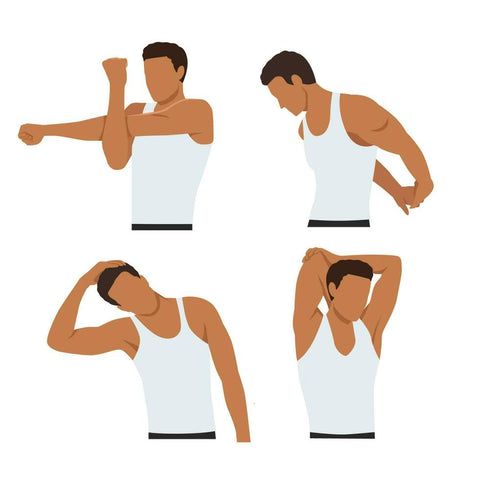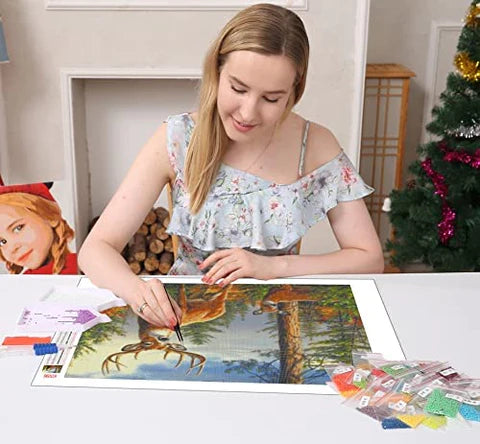You may have heard of "diamond painting" is a new trend that has been taking the crafting world by storm! It's similar to cross-stitch and paint-by-numbers, but with sparkly diamonds instead of thread or paint. Diamond painting is a great way to relax and unwind, and it's also a lot of fun! But like any new hobby, it can be a bit daunting at first.
One of the main things that people struggle with when they start diamond painting is the pain in their hands, back, and neck. In this, article we will talk about the ways and things that you can do to reduce your pain as well as avoid pain, in the first place.
Challenges in making a diamond painting
If you're new to painting with diamonds, then you might not be used to the repetitive motions and sitting for too long. After a few hours of painting, your hands will start to hurt. Your back and neck will also start to ache. One of the most common complaints when doing the diamond painting is pain in the hands, back, and neck.
This is because these areas are not used to the intense level of concentration that is required to complete this activity. Sitting in an uncomfortable position for extended periods of time or using incorrect posture when working on the "diamond painting project" and of course, the repetitive motion of picking up and placing tiny diamonds leads to these discomforts.

Pain in hands, neck, and back while painting with diamonds
Are you experiencing pain in your hands, neck, and back while making a diamond painting? If so, you're not alone. Many people experience discomfort while working on these paintings.
The pain can be quite severe for some people and can significantly reduce the time they are able to spend on diamond painting. The hands, neck, and back are the most common areas of pain when "painting with diamonds." This is because they are all used in the process of creating the painting. The hands are used to hold the pen and pick and place diamonds on the canvas, the neck is used to look at the work in progress and the back is used to keep the person upright.
- The hands can experience pain from the repetitive use of the applicator pen tool used to apply the diamonds to the painting.
- The back can experience pain from sitting in one position for an extended period of time while working on a diamond artwork.
- The neck can experience pain from looking down at the work surface for an extended period of time.

Why Pain is caused in hands, neck, and back?
One of the questions people often ask is why they experience pain in their hands, neck, and back when they make a diamond painting. There are a few reasons for this.
First, diamond paintings require a lot of precision and focus. This can lead to tension in the hands, neck, and back as people try to ensure that every diamond is in the right place. Second, people often have to lean in close to the canvas to see the tiny diamonds clearly, which can cause discomfort in these areas. And finally, many people find that they need to constantly adjust their posture while working on a diamond painting, which can also lead to pain.
While these issues can be frustrating, they are ways to avoid and alleviate these pains.

How to avoid hands, neck, and back pain?
Do you love diamond painting? If so, you're likely familiar with the discomfort it can cause. Diamond painting is a fun and easy way to create beautiful art, but it can also be quite taxing on your hands, neck, and back. This can lead to a less comfortable and bad experience and slower work. These pains are "common complaints" among diamond painters. Here are some things that you can do to avoid and alleviate these problematic pains.
Taking a break
It is no secret that long periods of time spent sitting or standing can lead to pain in the hands, neck, and back. For those who make diamond paintings, this can be a real issue. Luckily, there are some things you can do to help avoid pain. One is to take breaks often. Taking breaks every 30-60 minutes can help you avoid pain in those areas. Some people might think that they don’t have time for breaks, but you should actually try to take a five-minute break every hour. This will help refresh your body and mind, and you’ll be able to work more efficiently.
Here are a few tips for taking breaks:
- Get up and move around: A quick walk around the house or yard will help get your blood flowing and your muscles moving.
- Stretch your hands, neck, and back: There are plenty of easy stretches you can do to help relieve tension. Plus, this will keep your muscles loose and flexible.
- Drink plenty of water: Staying hydrated will help keep your muscles loose.
- Take a few deep breaths: Deep breathing helps oxygenate your body and relaxes your mind and muscles.
Take a 5-10 minute break every hour to rest your eyes and relax your body. During this break, you can do some light stretching or just sit back and relax, you can walk around, or drink some water.
Stretching your hands, neck, and back
In the world of Diamond Painting, pain in the hands, neck, and back is a common occurrence.
Diamond painting can be physically demanding. Many people report pain after a long session of diamond painting. Here are a few tips to help stretch those areas and minimize the pain as well as to avoid it.
- Start by stretching your hands, extend your arms out in front of you and then slowly curl them up towards your chest. You can also make a fist and then rotate your wrists in each direction. Stretch your hands by interlocking your fingers and then pushing them up and away from each other.
- Next, stretch your neck. Tilt your head to the right, then to the left. Hold each position for 10 seconds before releasing. Finally, extend your neck forward and hold for 10 seconds before releasing.
- To finish up, stretch your back. Reach both arms overhead and clasp your hands together. Bend from the waist and reach as far down toward your feet as you can comfortably go.
Follow these guidelines in order to totally avoid discomfort in your neck, back, and hands when making a diamond painting.

Make a good posture
Many people experience pain in their hands, neck, and back while making a diamond painting due to incorrect posture. To avoid pain, it is important to maintain good posture throughout the entire process. Here are a few tips for doing so:
- Keep your spine straight. Do not slouch or hunch over while working on your painting. When you are hunched over your artwork, it puts strain on your neck, shoulders, and back. This can lead to pain in those areas. If your back is not straight, you may end up sitting in an awkward position which can cause pain in your neck and back. Keeping your back straight and avoiding slouching will help prevent back pain.
- Make sure your chair is at the right height so that your arms are bent at a 90-degree angle when you're working. This will reduce the strain on your hands, neck, and back. If it's too low, you will have to hunch over which can cause pain in your neck and back. If it's too high, you will have to stretch your arms out which can cause pain in your hands and wrists.
- Make sure to keep your head up and do not tilt your head down or sideways while working on your painting. Keep your elbows close to your body and use a light touch when dabbing the diamonds onto the canvas. Applying too much pressure can cause fatigue and pain in your hands and wrists. Making your head upright and looking forward, rather than bending it down towards the canvas will also avoid pain in your neck and upper back.
Following these tips should help you to avoid pain in your hands, neck, and back while making a diamond painting.

Organize your workspace
The popularity of diamond painting has exploded in recent years. This craft is a fun way to relax and pass the time, but it can also be quite challenging. One of the biggest culprits of neck, hand, and back pain while painting is having an unorganized work area. When your work area is cluttered, it's difficult to find the supplies you need when you need them. This can lead to unnecessary stress and fatigue, which can cause pain in these areas.
Here are a few tips to help organize your workspace and reduce pain:
- Make sure your work surface is large enough to accommodate your painting. If possible, use a table that is at least 30 inches wide. This will avoid strain on your hands, neck, and back.
- Place your painting in the center of the work surface. This will help you avoid reaching too far to the sides and causing pain in your neck and shoulders.
- Keep all of your materials within easy reach. Having everything you need close by will help you avoid having to move around excessively, which can cause pain in your hands and back.
The tips presented here will help you avoid muscle pain, neck pain, and back pain while making your painting with diamonds.

Get a comfortable chair
It’s no secret that prolonged sitting can be bad for your health. But did you know that it can also cause pain in the hands, neck, and back? This is especially true if you’re engaged in an activity like diamond painting, which requires a lot of focus and repetitive movement. When it comes to diamond painting, comfort is key. Not only will you be more productive if you're comfortable, but you'll also avoid pain in your hands, neck, and back. A good chair is key for avoiding pain while painting.

Look for a chair with good lumbar support, an adjustable height, and a wide base so it doesn't move around as you work. If you're short on space, try a drafting chair that can be easily moved out of the way when you're not using it. Make sure the armrests are adjustable so that you can find the perfect position for your arms. The back of the chair should also be adjustable so that you can recline and support your lower back.
If you are going to be sitting in this position for an extended period of time, it is important to make sure your feet are supported as well. Place a footrest or stool under your feet to keep them from getting tired.
These tips will reduce the possibility of pain in your shoulders, neck, and back while a great diamond painting.
Use the applicator pen correctly
There is no denying that diamond painting is therapeutic. It's a fun and addictive way to take your mind off of things, and the finished product is always beautiful. However, many people experience pain in their hands, neck, and back while making diamond paintings. One of the causes of discomfort and pain can be the diamond applicator pen itself. Holding the pen applicator for extended periods of time or not using correctly can lead to pain. The following tips can help you avoid this pain:
- Make sure to hold the applicator pen correctly. You should hold it like you would a pencil, with your thumb and index finger gripping the barrel of the pen.
- Apply pressure to the canvas with the tip of the pen instead of pushing down on the entire surface of the pen. This will allow you to apply more pressure when needed.
-
Move your hand up and down as you apply diamonds, rather than moving it from side to side. This will help keep your hand in a more comfortable position.

Alternatively, there are other things that you can do to make the process a bit more comfortable.
- Try using a different applicator pen. Some people find that using a pen with a wider barrel or a longer handle makes it easier to hold and reduces the amount of pain they experience. You can also try wrapping your hand around the barrel of the pen to create more support.
- If that doesn’t help, you may want to consider buying an ergonomic applicator pen. These pens are designed to reduce strain on your hands and arms, making them a great option for people who experience pain while diamond painting.
Interesting tips to combat diamond painting challenges
Here are some useful tips & tricks to avoid hands, neck, and back pain in diamond painting:
- Use a comfortable chair with good back support and sit up straight while diamond painting.
- Take frequent breaks to stretch and move around to prevent stiffness and soreness.
- Use a neck pillow or support to prevent neck strain while looking down at the canvas.
- Adjust the height of the table or work surface to a comfortable level that reduces strain on your neck and back.
- Avoid diamond painting in a cramped or uncomfortable space that can cause tension in your body.
- Use a grip or padded sleeve on the stylus to prevent pressure and pain in your fingers and hand.
- Take frequent breaks to flex your fingers and stretch your hands to prevent cramping.
- Use a magnifying glass or light to reduce eye strain and prevent headaches.
- Use a larger stylus or pen to reduce the need for a tight grip on the smaller stylus tool.
- Consider using a wrist support or brace to prevent strain and pain in your wrist.
- Use a comfortable and supportive pair of shoes to prevent leg and foot pain during long diamond painting sessions.
- Consider using a lap desk or easel to reduce strain on your neck and back.
- Practice good posture while diamond painting to reduce strain on your muscles and joints.
- Use a comfortable and supportive pair of gloves to prevent hand fatigue and pain.
- Try yoga or other exercises that can improve your flexibility and reduce tension in your body.
Happy Diamond Painting!
Diamond painting is a fun, easy way to create beautiful art, but it can also be very frustrating. Many people experience pain in their hands, neck, and back while making diamond paintings. This pain can be caused by many things, such as poor posture, using the wrong tools, or working for too long without taking a break. While the cause of the pain may vary from person to person, there are a few things that you can do to help alleviate it and avoid it. If you are experiencing pain while diamond painting, be sure to take breaks often, use the right tools, and maintain good posture. If the pain persists, see a doctor. Diamond painting can be a fun and rewarding hobby, but it's important to take care of your body while doing it.
Though it can be tiring at times, the end result is always worth it!








